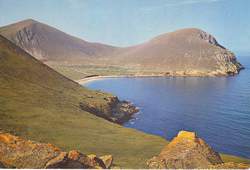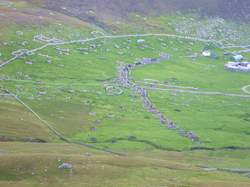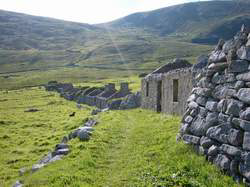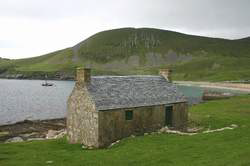Abandoned Communities ..... St Kilda
On 10 May 1930 the people of St Kilda sent a collective letter to William Adamson, the Secretary of State for Scotland, requesting that they should be evacuated from their home. By the end of August that year the evacuation was completed and the process of resettlement on the Scottish mainland had begun. The abandonment of St Kilda is sometimes described as one of the few occasions when the ending of a community has taken place in a voluntary fashion. We will see, however, that while the adult members of the St Kilda community came to a unanimous decision that it would be right to leave many of them were in fact reluctant to sign the letter. Behind the decision, moreover, lay a complex pattern of social changes over a long period of time that had transformed a stable and contented community into one that saw no future for itself.
St Kilda is a small group of islands in the Atlantic Ocean. It lies just over a hundred miles from the mainland of Scotland, and about 45 miles west of North Uist in the Outer Hebrides. Hirte is easily the largest island, but even Hirte is only about two miles from east to west and about the same distance from north to south. The homes and crofts of the people of St Kilda were on Hirte, on the south east side of the island on a bay that came to be known as Village Bay. There are three other islands, and also a number of spectacular rock stacks. Two of the stacks, Stac Lee and Stac an Armin, close to the island of Boreray, rise from the sea to a height of almost two hundred metres.
A more detailed description of the geography of St Kilda and a series of maps can be found in Chapter 2 of Mary Harman's book An Isle Called Hirte: History and Culture of the St Kildans to 1930, Maclean Press, 1997.
Alternatively, go to the website of the National Trust for Scotland.
The social organisation of the people of St Kilda can be summed up as a form of feudal communism. It was a feudal community in the sense that the islands were the property of a wealthy landowner who lived elsewhere but for most of the history of the community had total control over the way of life of the islanders if he wished to exercise it. At the time of the evacuation the owner was Reginald MacLeod, whose main home was at Dunvegan on the Isle of Skye. He claimed that the population of St Kilda had been "tenants of my family for a thousand years". His claim cannot be verified, but it is quite possible that it was correct.
The landowner expected to receive regular rent from the islanders. Until the nineteenth century money was not used on St Kilda, and the rent was paid in the form of goods that could be sold by the landowner. Foremost among the goods produced on Hirte were the feathers and oil obtained from sea birds. In addition a proportion of the limited production of agricultural goods might be sent, and in later years woven tweed cloth was included.
The relationship between landowner and crofters was one that could potentially be marked by exploitation and oppression. In practice most owners accepted an obligation to care for their tenants. Food and other supplies not available on the islands would be provided to them, and during periods of hardship extra assistance would be given and some of the rent would be remitted. It was generally in the owner's interests to make sure that the people of St Kilda had an adequate standard of living and would therefore be willing and able to go on generating the annual rent.
The landowner rarely had direct contact with the people of St Kilda. Instead he used a representative, known variously as the steward, tacksman, or factor. The steward spent some time on Hirte every summer, bringing with him supplies needed by the people, and taking away the goods that formed the rent. In addition to the rent the steward would remove goods he would retain for himself as part of the deal he had with the landowner. The steward could be accompanied by a party of people, sometimes numbering fifty or so and including a number of poor people, who by convention were expected to receive hospitality from the islanders throughout their stay.
There may have been more scope for exploitation in the relationship between the steward and the people. Some safeguard against it seems to have been provided in the role of the "Ground Officer", a member of the St Kilda community who on the one hand carried out certain duties on behalf of the steward but who at the same time could take the side of the islanders if they had a dispute with the steward. As a last resort the people had the right to appeal to the landowner. It seems this right was very rarely exercised, not least because it entailed a long and often hazardous voyage in a very small boat to get to Dunvegan. When an appeal was made it appears that a considerable degree of obsequiousness was expected to be displayed by the islanders. Martin Martin, who wrote a detailed account of his visit to St Kilda near the end of the seventeenth century, reported that the ground officer would "take off his bonnet at a great distance when he appears in MacLeod's presence, bowing his head and hand low near the ground, his retinue doing the like behind him".
Martin Martin, A Late Voyage to St Kilda, 1698.
St Kilda is a small group of islands in the Atlantic Ocean. It lies just over a hundred miles from the mainland of Scotland, and about 45 miles west of North Uist in the Outer Hebrides. Hirte is easily the largest island, but even Hirte is only about two miles from east to west and about the same distance from north to south. The homes and crofts of the people of St Kilda were on Hirte, on the south east side of the island on a bay that came to be known as Village Bay. There are three other islands, and also a number of spectacular rock stacks. Two of the stacks, Stac Lee and Stac an Armin, close to the island of Boreray, rise from the sea to a height of almost two hundred metres.
A more detailed description of the geography of St Kilda and a series of maps can be found in Chapter 2 of Mary Harman's book An Isle Called Hirte: History and Culture of the St Kildans to 1930, Maclean Press, 1997.
Alternatively, go to the website of the National Trust for Scotland.
The social organisation of the people of St Kilda can be summed up as a form of feudal communism. It was a feudal community in the sense that the islands were the property of a wealthy landowner who lived elsewhere but for most of the history of the community had total control over the way of life of the islanders if he wished to exercise it. At the time of the evacuation the owner was Reginald MacLeod, whose main home was at Dunvegan on the Isle of Skye. He claimed that the population of St Kilda had been "tenants of my family for a thousand years". His claim cannot be verified, but it is quite possible that it was correct.
The landowner expected to receive regular rent from the islanders. Until the nineteenth century money was not used on St Kilda, and the rent was paid in the form of goods that could be sold by the landowner. Foremost among the goods produced on Hirte were the feathers and oil obtained from sea birds. In addition a proportion of the limited production of agricultural goods might be sent, and in later years woven tweed cloth was included.
The relationship between landowner and crofters was one that could potentially be marked by exploitation and oppression. In practice most owners accepted an obligation to care for their tenants. Food and other supplies not available on the islands would be provided to them, and during periods of hardship extra assistance would be given and some of the rent would be remitted. It was generally in the owner's interests to make sure that the people of St Kilda had an adequate standard of living and would therefore be willing and able to go on generating the annual rent.
The landowner rarely had direct contact with the people of St Kilda. Instead he used a representative, known variously as the steward, tacksman, or factor. The steward spent some time on Hirte every summer, bringing with him supplies needed by the people, and taking away the goods that formed the rent. In addition to the rent the steward would remove goods he would retain for himself as part of the deal he had with the landowner. The steward could be accompanied by a party of people, sometimes numbering fifty or so and including a number of poor people, who by convention were expected to receive hospitality from the islanders throughout their stay.
There may have been more scope for exploitation in the relationship between the steward and the people. Some safeguard against it seems to have been provided in the role of the "Ground Officer", a member of the St Kilda community who on the one hand carried out certain duties on behalf of the steward but who at the same time could take the side of the islanders if they had a dispute with the steward. As a last resort the people had the right to appeal to the landowner. It seems this right was very rarely exercised, not least because it entailed a long and often hazardous voyage in a very small boat to get to Dunvegan. When an appeal was made it appears that a considerable degree of obsequiousness was expected to be displayed by the islanders. Martin Martin, who wrote a detailed account of his visit to St Kilda near the end of the seventeenth century, reported that the ground officer would "take off his bonnet at a great distance when he appears in MacLeod's presence, bowing his head and hand low near the ground, his retinue doing the like behind him".
Martin Martin, A Late Voyage to St Kilda, 1698.
One
Village Bay
Another view
The main street
The feather store (restored), where feathers were kept to be paid as rent
Some of the pictures in this section come from www.geograph.org.uk.
They include photographs taken by Bill Booth and Rob Jones. Those by Bill Booth were taken during a voyage on Coronette in August 2005
They include photographs taken by Bill Booth and Rob Jones. Those by Bill Booth were taken during a voyage on Coronette in August 2005



